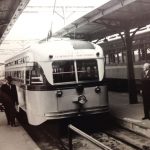PCC Test on the Long Beach Line: A Very Expensive Bunch of “BS”
By Ralph Cantos
When the first Los Angeles Metropolitan Transit Authority (LAMTA) took over the operations of the Los Angeles Transit Lines (ex-Los Angeles Railway) and Metropolitan Coach Lines (ex-Pacific Electric) in March of 1958, I (as a 15-year-old railfan) was foolishly optimistic to actually think that LA was on the threshold of a new beginning in public transit. LA newspapers published photos of abandoned PE rights of ways, proclaiming that rail rapid transit would make a dramatic comeback to LA under the guidance of the “transit experts” who were supposedly part of the first LAMTA.
But as all rail fans in Los Angeles soon found out, rail rapid transit was the last thing the LAMTA had in mind for LA commuters. First order of business was to finish what Metropolitan Coach Lines had failed to do — that being the abandonment of the Bellflower Line just two months after the MTA’s inauguration. Over the next two years, rail service on the San Pedro and Watts lines was abandoned in quick succession.
Then in February 1960, just two months after the Watts line an abandonment, the MTA conducted test with former Los Angeles Transit Lines PCC no. 3148 riding on standard gauge PCC trucks on loan from San Francisco Muni. The 3148 made test runs along the length of the Long Beach Line, sometimes in reverse.
In my opinion, this was all a bunch of “BS.”
In this photo taken at 6th & Main Station in February 1960, the 3148 departs under the watchful eyes of 50-year-old Blimp no. 1708. The MTA concluded that the test went very well. To convert the Long Beach Line to single-end PCC operation would have meant that reverse loops would have to be constructed at 6th & Main and in Long Beach. PE’s beautiful double-end PCCs were available, but the LAMTA did nothing and the double-enders were sold to Buenos Aires.
In one last bit of MTA “BS,” Blimp no. 1543 was given a hasty two-tone green paint job to show Long Beach Line commuters that the LAMTA really wanted to continue rail service on the line.
But even before the green paint job on the 1543 could fully cure, LAMTA announced that the line would be converted to bus operation on April 9, 1961. The MTA said the the Southern Pacific Railroad (who owned the tracks) would not renew the lease on the right-of-way. In my opinion, MORE BS. The LAMTA was a state agency that could have told the SP to stick it where the sun don’t shine. An so, that was that.
Next order of business, complete destruction of LA’s five modern, excellent PCC-operated car lines, and for good measure, the two clean electric trolley bus lines would be abandoned as well. So much for bringing rapid transit to LA, which in five short years became an all bus “town.”
Ralph Cantos Collection





It would be interesting to speculate what would have happened with the merger of the two old systems if the new “big daddy” MTA really wanted to keep things going. Could they have serviced the standard gauge cars at South Park Shops if they rebuilt the access tracks? I NEVER recall seeing fresh red P.E. paint (except over the renumbering) as a kid but L.A.R.Y. 3066 was practically completely repainted at the end – in the old yellow and green LATL colors! It was as if there were still two divergent systems going on autopilot!
As I recall, most PCC cars were repainted in LAMTA’s light green /dark green color scheme.
By 1962 the LAMTA wasn’t repainting the PCC’s anymore but they would touch up any rust or scrape damage – using the old yellow paint if necessary. #3100 looked like a new car from the front! But why the good maintenance on a system pre-doomed to be abandoned in a year or so? Was there anybody in the LAMTA in charge? After the scandal about the deposition of the trolley buses the whole agency seemed a bit sordid at times .
I read somewhere that PE1543 was not only repainted but its seats were rebuilt, and other interior work waa done.
The new seat cushions were leatherette bench seats. They were far less comfortable than the original velour form-fitting individual cushions.
PCCs need smooth firm track, I heard the test was a rough ride on the Long Beach line. I was 14 at the time and was harassed and threatened by MTA cops for posting and handing out “Save the Red Cars” leaflets.
I also gave the LAMTA a bad time. The FBI was sent to my house to investagate me. My mother told them “my son would never do a thing like that” .. Ralph Cantos
I suspect that the LAMTA management was eager to lay off the track workers and overhead line crews by abandoning the last electric transit service.
Not sure where I heard this, but supposedly in a city on the eastern side of the US, some of the “powers that be” wanted to build a light rail or streetcar line, and the management of the local transit system came out against it. They were making good livings overseeing a marginal bus service for the unfortunate souls who didn’t have their own cars to drive, why make life more complicated by getting into the railway business?
Had PE been serious about keeping rail passenger service, they would have been well advised to buy cars like the Philadelphia Suburban cars that St. Louis Car built in 1949. They used a double ended PCC style body, but had MCB trucks (more like Hollywood cars) and 75 hp motors more suitable for open country running. (Look up car 14 on the Pennsylvania Trolley Museum for an operating example)